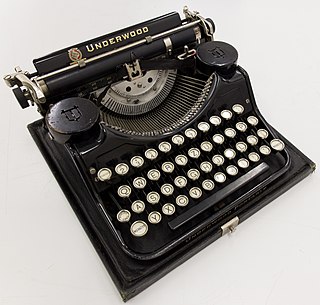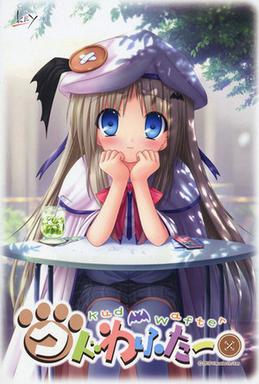
ASCII, an acronym for American Standard Code for Information Interchange, is a character encoding standard for electronic communication. ASCII codes represent text in computers, telecommunications equipment, and other devices. ASCII has just 128 code points, of which only 95 are printable characters, which severely limit its scope. The set of available punctuation had significant impact on the syntax of computer languages and text markup. ASCII hugely influenced the design of character sets used by modern computers, including Unicode which has over a million code points, but the first 128 of these are the same as ASCII.

ASCII art is a graphic design technique that uses computers for presentation and consists of pictures pieced together from the 95 printable characters defined by the ASCII Standard from 1963 and ASCII compliant character sets with proprietary extended characters. The term is also loosely used to refer to text-based visual art in general. ASCII art can be created with any text editor, and is often used with free-form languages. Most examples of ASCII art require a fixed-width font such as Courier for presentation.
The keyboard for IBM PC-compatible computers is standardized. However, during the more than 30 years of PC architecture being frequently updated, many keyboard layout variations have been developed.

The infinite monkey theorem states that a monkey hitting keys at random on a typewriter keyboard for an infinite amount of time will almost surely type any given text, including the complete works of William Shakespeare. In fact, the monkey would almost surely type every possible finite text an infinite number of times. The theorem can be generalized to state that any sequence of events that has a non-zero probability of happening will almost certainly occur an infinite number of times, given an infinite amount of time or a universe that is infinite in size.

A typewriter is a mechanical or electromechanical machine for typing characters. Typically, a typewriter has an array of keys, and each one causes a different single character to be produced on paper by striking an inked ribbon selectively against the paper with a type element. Thereby, the machine produces a legible written document composed of ink and paper. By the end of the 19th century, a person who used such a device was also referred to as a typewriter.

Roguelike is a style of role-playing game traditionally characterized by a dungeon crawl through procedurally generated levels, turn-based gameplay, grid-based movement, and permanent death of the player character. Most roguelikes are based on a high fantasy narrative, reflecting the influence of tabletop role-playing games such as Dungeons & Dragons.
A carriage return, sometimes known as a cartridge return and often shortened to CR, <CR> or return, is a control character or mechanism used to reset a device's position to the beginning of a line of text. It is closely associated with the line feed and newline concepts, although it can be considered separately in its own right.

The QWERTZQWERTZU, or QWERTZUIOP keyboard is a typewriter and keyboard layout widely used in Central and Southeast Europe. The name comes from the first six letters at the top left of the keyboard:.

The tab keyTab ↹ on a keyboard is used to advance the cursor to the next tab stop.

The pound sign is the symbol for the pound unit of sterling – the currency of the United Kingdom and its associated Crown Dependencies and British Overseas Territories and previously of Great Britain and of the Kingdom of England. The same symbol is used for other currencies called pound, such as the Egyptian and Syrian pounds. The sign may be drawn with one or two bars depending on personal preference, but the Bank of England has used the one-bar style exclusively on banknotes since 1975.

An underscore or underline is a line drawn under a segment of text. In proofreading, underscoring is a convention that says "set this text in italic type", traditionally used on manuscript or typescript as an instruction to the printer. Its use to add emphasis in modern finished documents is generally avoided.
The backtick` is a typographical mark used mainly in computing. It is also known as backquote, grave, or grave accent.

Backspace is the keyboard key that in typewriters originally pushed the carriage one position backwards, and in modern computer systems typically moves the display cursor one position backwards, deletes the character at that position, and shifts back any text after that position by one character.

A typographical error, also called a misprint, is a mistake made in the typing of printed or electronic material. Historically, this referred to mistakes in manual typesetting. Technically, the term includes errors due to mechanical failure or slips of the hand or finger, but excludes errors of ignorance, such as spelling errors, or changing and misuse of words such as "than" and "then". Before the arrival of printing, the copyist's mistake or scribal error was the equivalent for manuscripts. Most typos involve simple duplication, omission, transposition, or substitution of a small number of characters.

The IBM 2741 is a printing computer terminal that was introduced in 1965. Compared to the teletypewriter machines that were commonly used as printing terminals at the time, the 2741 offers 50% higher speed, much higher quality printing, quieter operation, interchangeable type fonts, and both upper and lower case letters.

Filler text is text that shares some characteristics of a real written text, but is random or otherwise generated. It may be used to display a sample of fonts, generate text for testing, or to spoof an e-mail spam filter. The process of using filler text is sometimes called greeking, although the text itself may be nonsense, or largely Latin, as in Lorem ipsum.

A computer keyboard is a peripheral input device modeled after the typewriter keyboard which uses an arrangement of buttons or keys to act as mechanical levers or electronic switches. Replacing early punched cards and paper tape technology, interaction via teleprinter-style keyboards have been the main input method for computers since the 1970s, supplemented by the computer mouse since the 1980s.

The IBM Selectric was a highly successful line of electric typewriters introduced by IBM on 31 July 1961.

Kud Wafter is a Japanese adult visual novel developed by Key, released on June 25, 2010, for Windows. Kud Wafter is Key's eighth game, along with other titles such as Kanon, Air, and Clannad. Key released a version of Kud Wafter without the erotic content, and the game was ported to the PlayStation Portable and PlayStation Vita. The story follows the lives of high school students Riki Naoe and his close friend Kudryavka Noumi as they start to see more of each other in a romantic relationship. The gameplay in Kud Wafter follows a branching plot line which offers pre-determined scenarios with courses of interaction, and focuses on the appeal of the title character Kudryavka, also known as "Kud" for short.
Caret is the name used familiarly for the character ^ provided on most QWERTY keyboards by typing ⇧ Shift+6. The symbol has a variety of uses in programming and mathematics. The name "caret" arose from its visual similarity to the original proofreader's caret, ‸, a mark used in proofreading to indicate where a punctuation mark, word, or phrase should be inserted into a document. The ASCII standard (X3.64.1977) calls it a "circumflex"; the Unicode standard calls it a "circumflex accent", although it is no longer practicable for that purpose.

















